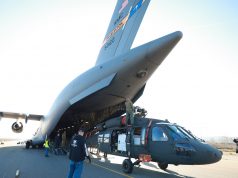
The US Air Force is trialing aerodynamic technologies that would allow its mobility aircraft to improve airflow, reduce maintenance issues, increase payload capability, and decrease fuel demand.
Air Mobility Command, the Air Force Research Laboratory, and Air Force Operational Energy have partnered with commercial vendors to research, design, test, and certify a number of these innovations into the mobility fleet, including the KC-135 Stratotanker, C-17 Globemaster III, and C-130 Hercules.
Each initiative is at various phases of development and transition, gaining momentum with the influx of funding from the Fiscal Year 2022 Presidential Budget.
With a fleet as large as the one operated by the US Air Force, small adjustments can make a big impact, including the positioning of windshield vipers. In 2020, the service calculated that changing the position of wiper blades on the KC-135 Stratotanker from horizontal to vertical would save it $7 million in fuel costs annually.
“Optimization programs like these just make sense for the Air Force,” said Deputy Assistant Secretary of Air Force Operational Energy Roberto Guerrero. “My office has been working to advance initiatives that not only make us smarter about how we consume fuel, but also help to prevent maintenance issues, increase engine performance and improve mission planning.”
After several years of research and testing, microvanes for the C-17 are in the process of airworthiness certification at the AFRL and the Air Force Life Cycle Management Center. Microvanes are small 3D-printed structures that attach to the aft-end of the fuselage. The fin-like shape helps redirect airflow in this higher drag area, streamlining the aerodynamics and reducing overall fuel demand by approximately 1%.
When installed across the C-17 fleet, including Air National Guard and Air Force Reserve aircraft, the Air Force estimates the microvanes will pay for themselves in fuel savings in seven months, and save over $10 million per year.
The Air Force is evaluating vertical wiper blades on the KC-135 as another airstream drag reduction project that will improve fuel economy, range, and capacity. Across the KC-135 fleet, windshield wiper blades have been placed horizontally for over 60 years; however, aerodynamic ground testing confirmed that adjusting the wipers to sit vertically will optimize the aircraft by about 1%, a potential fuel savings of over $7 million across the fleet. Now, the wipers will progress to airworthiness flight testing where they will be installed on several aircraft.
The KC-135 has also been undergoing testing for a replacement engine fan duct panel that can better withstand corrosion and water contamination. The current KC-135 fan ducts have aluminum panels which are susceptible to corrosion and degradation when exposed to water and debris over an extended period of time. The current repair to this corrosion inhibits airflow to the engine, reducing performance and increasing fuel use by an estimated $5.5 million each year. Additionally, aircraft are often out of operation for over two days while the maintenance crews work to fix this recurring issue that affects a majority of the KC-135 fleet.
The replacement panel is made of a composite material that is impervious to similar degradation and corrosion. This one-time fix will eliminate frequent inspections and panel repairs. Flight evaluations start this December and run through February. Once certified, the team hopes to replace the panel across the entire KC-135 fleet.
These initiatives are just a select few that are farthest along in their development. The Air Force noted it is working with the commercial industry and defense partners on several other optimization initiatives including other drag reduction efforts, engine sustainment and propulsion improvements for legacy aircraft, mission planning software upgrades, process optimization, transformational aircraft body designs, and more.


























